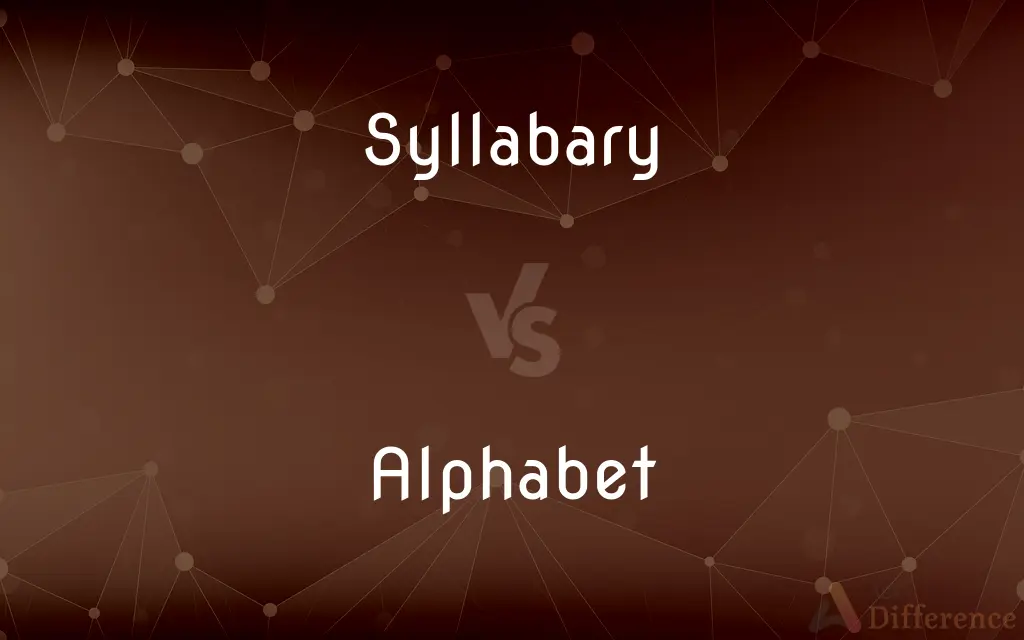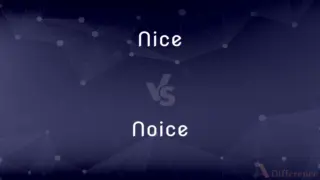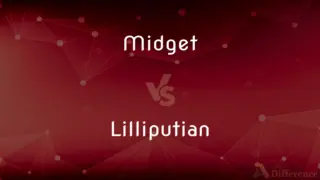Syllabary vs. Alphabet — What's the Difference?
By Urooj Arif & Maham Liaqat — Updated on April 14, 2024
Syllabaries represent whole syllables with symbols, whereas alphabets use individual letters for phonemes, allowing for more versatile spelling.

Difference Between Syllabary and Alphabet
Table of Contents
ADVERTISEMENT
Key Differences
A syllabary, such as the Japanese kana, assigns a distinct symbol to each syllable used in the language, which simplifies pronunciation but increases the number of symbols needed. On the other hand, an alphabet, like the Roman alphabet used in English, comprises a smaller set of letters that represent individual phonemes (sounds), making it more flexible and adaptable to different languages.
In syllabaries, each symbol typically stands for a consonant-vowel combination, which can make reading straightforward but writing and memorization more challenging due to the large number of characters. Whereas, alphabets can efficiently construct a vast array of words with far fewer characters by combining letters in various ways.
Syllabaries are often closely tied to the specific phonetic structure of a language, making them less adaptable but very intuitive for native speakers. Alphabets, however, offer the versatility needed to phonetically represent a wide range of languages, albeit at the cost of potential complexities in pronunciation rules.
The learning curve for a syllabary can be steeper initially due to the need to memorize a larger set of symbols. Conversely, alphabets, with fewer characters to learn, may offer a quicker start in literacy but require more understanding of spelling conventions and phonetics.
While a syllabary can be more visually distinct, making each symbol unique and sometimes easier to distinguish, an alphabet’s simplicity and repetitiveness of characters can aid in learning to spell and phonetically decode words more systematically.
ADVERTISEMENT
Comparison Chart
Basic Unit
Syllable (e.g., "ka", "shi")
Phoneme (e.g., "k", "a")
Symbol Count
Many, often 50-100
Fewer, typically 20-30
Adaptability
Low; tailored to specific languages
High; can represent multiple languages
Ease of Learning
Higher initial learning curve
Easier initial learning but complex phonetics
Representation
Direct representation of spoken language structure
Abstract representation of sounds
Compare with Definitions
Syllabary
A set of written symbols that each represent a syllable.
In the Cherokee syllabary, the symbol Ꭰ stands for the syllable a.
Alphabet
Allows flexible spelling and word creation.
Letters can be combined in myriad ways to form words.
Syllabary
Typically found in languages with simple syllable structures.
The Vai syllabary is used in Liberia.
Alphabet
Typically requires mastery of spelling rules.
C can sound like s or k depending on the context.
Syllabary
Each symbol is phonetically complete.
In the Cree syllabary, ᒥ stands for mi.
Alphabet
A set of letters, each representing one or more sounds.
The English alphabet begins with A, B, C.
Syllabary
A writing system used to phonetically convey sounds.
The Japanese hiragana character し represents the syllable shi.
Alphabet
Used in multiple languages with variations.
The Spanish alphabet includes ñ unlike the English alphabet.
Syllabary
Consists of more characters than alphabets.
Katakana includes a symbol for each distinct syllable in Japanese.
Alphabet
Often has fewer symbols than a syllabary.
The Greek alphabet has 24 letters.
Syllabary
In the linguistic study of written languages, a syllabary is a set of written symbols that represent the syllables or (more frequently) moras which make up words. A symbol in a syllabary, called a syllabogram, typically represents an (optional) consonant sound (simple onset) followed by a vowel sound (nucleus)—that is, a CV or V syllable—but other phonographic mappings, such as CVC, CV- tone, and C (normally nasals at the end of syllables), are also found in syllabaries.
Alphabet
An alphabet is a standardized set of basic written symbols or graphemes (called letters) that represent the phonemes of certain spoken languages. Not all writing systems represent language in this way; in a syllabary, each character represents a syllable, for instance, and logographic systems use characters to represent words, morphemes, or other semantic units.The first fully phonemic script, the Proto-Canaanite script, later known as the Phoenician alphabet, is considered to be the first alphabet, and is the ancestor of most modern alphabets, including Arabic, Cyrillic, Greek, Hebrew, Latin, and possibly Brahmic.
Syllabary
A list of syllables.
Alphabet
The letters of a language, arranged in the order fixed by custom.
Syllabary
A set of written characters for a language, each character representing a syllable.
Alphabet
A system of characters or symbols representing sounds or things.
Syllabary
(orthography) A table or list of syllabic letters or syllables.
Alphabet
A set of basic parts or elements
"genetic markers ... that contain repeated sequences of the DNA alphabet"(Sandra Blakeslee).
Syllabary
(orthography) A writing system where each character represents a complete syllable.
It shouldn't be hard to come up with a musical syllabary in which pitches code for vowels and timbres code for consonants.
Alphabet
The set of letters used when writing in a language.
The Greek alphabet has only twenty-four letters.
In the first year of school, pupils are taught to recite the alphabet.
Syllabary
A table of syllables; more especially, a table of the indivisible syllabic symbols used in certain languages, as the Japanese and Cherokee, instead of letters.
Alphabet
A writing system in which letters represent phonemes. Contrast e.g. logography, a writing system in which each character represents a word, and syllabary, in which each character represents a syllable.
Syllabary
A writing system whose characters represent syllables
Alphabet
A writing system in which there are letters for the consonant and vowel phonemes. Contrast e.g. abjad.
Alphabet
(computer science) A typically finite set of distinguishable symbols.
Let be a regular language over the alphabet .
Alphabet
An individual letter of an alphabet; an alphabetic character.
Alphabet
The simplest rudiments; elements.
Alphabet
An agent of the FBI, the CIA, or another such government agency.
Alphabet
(rare) To designate by the letters of the alphabet; to arrange alphabetically.
Alphabet
The letters of a language arranged in the customary order; the series of letters or signs which form the elements of written language.
Alphabet
The simplest rudiments; elements.
The very alphabet of our law.
Alphabet
To designate by the letters of the alphabet; to arrange alphabetically.
Alphabet
A character set that includes letters and is used to write a language
Alphabet
The elementary stages of any subject (usually plural);
He mastered only the rudiments of geometry
Common Curiosities
How many symbols does a typical alphabet have?
Most alphabets have between 20 and 30 symbols.
What is an alphabet?
An alphabet is a set of letters that represent individual sounds or phonemes within a language.
Is it easier to learn to write with a syllabary or an alphabet?
Learning to write with an alphabet is generally easier due to fewer symbols, though mastering it can be complex due to phonetic rules.
Can a syllabary be used for any language?
No, syllabaries are typically specific to languages with relatively simple syllable structures.
What is a syllabary?
A syllabary is a set of written characters where each character represents a syllable.
Can alphabets represent different languages?
Yes, alphabets can be adapted to represent a wide range of languages by modifying the set of letters.
What are examples of syllabaries?
Japanese hiragana and katakana, and the Cherokee syllabary are examples.
How does a syllabary differ from an ideographic script?
A syllabary represents syllables phonetically, whereas ideographic scripts symbolize ideas or concepts.
Is the English writing system a syllabary?
No, English uses an alphabet where each letter primarily represents individual sounds.
What are examples of alphabets?
The Roman alphabet, Cyrillic alphabet, and Greek alphabet are examples.
How does the adaptability of alphabets compare to syllabaries?
Alphabets are generally more adaptable to different languages than syllabaries.
Why do syllabaries have more symbols than alphabets?
Syllabaries need a unique symbol for each syllable in the language, resulting in a larger set of characters.
Do alphabets need additional diacritics or marks?
Often, alphabets use diacritics to modify sound values (e.g., accents in Spanish).
Are syllabaries more intuitive for speakers of their languages?
Yes, syllabaries can be more intuitive for native speakers as they closely match the spoken form of the language.
Share Your Discovery

Previous Comparison
Nice vs. Noice
Next Comparison
Midget vs. LilliputianAuthor Spotlight
Written by
Urooj ArifUrooj is a skilled content writer at Ask Difference, known for her exceptional ability to simplify complex topics into engaging and informative content. With a passion for research and a flair for clear, concise writing, she consistently delivers articles that resonate with our diverse audience.
Co-written by
Maham Liaqat














































